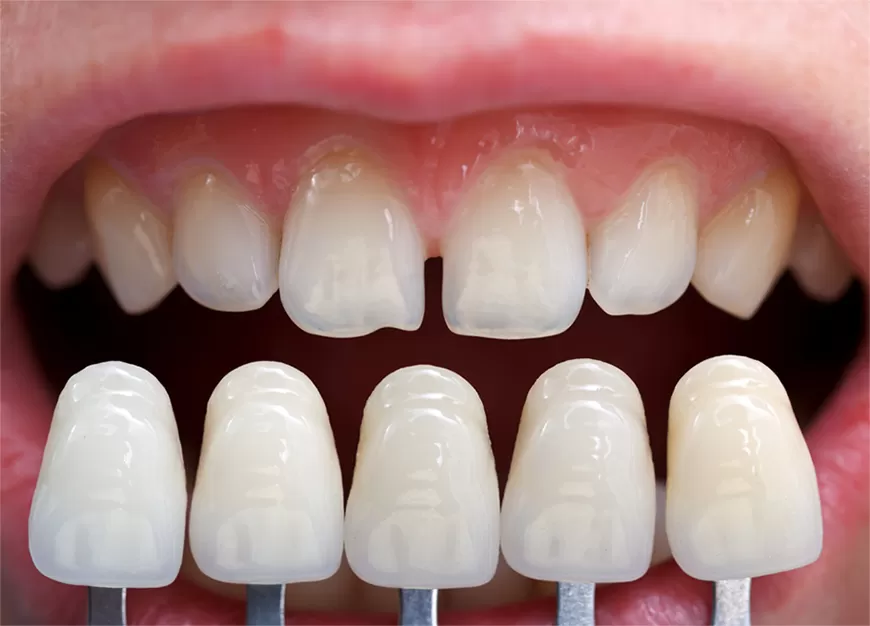Dental veneers, often also termed as dental porcelain laminates or porcelain veneers, are thin, tailor-made cases of material having similar color of teeth, crafted to cover the front teeth with an objective to improve the overall facial look. These cases are attached to the front teeth as per the color, shape, length and size of the teeth. It is a cosmetic dentistry science aims at providing better appearance and personality to people suffering from some kind of dental disorder that is affecting their smile appearance adversely.
These veneers are made from resin or porcelain composite substances. Veneers made of porcelain are stronger than resin products and have more resemblance and characteristics of natural teeth. On the other hand veneers made of resin are thinner, so to place this less enamel from the teeth needs to be removed. It is entirely your dental condition that can enable the cosmetic dentist to select the best veneer for you.
Why to Wear Dental Veneers
The causes that can lead towards veneers placement in your teeth may include:
- Discolored Teeth (due to stains from drugs or tetracycline, root canal procedure, excessive fluoride and resin fillings)
- Shabby Teeth
- Chipped or Broken Teeth
- Misaligned, Irregularly Shaped and Uneven Teeth
- Teeth with Gaps
Procedure of Dental Veneer
This process generally requires you to visit your cosmetic dentist thrice. Initial one for a consultation and the rest two to design and apply the veneers. For veneer you need to undergo the veneering process as mentioned below.
Initial Diagnosis and Treatment Consultation: The initial step requires your participation to understand and accept the situation. You should intimate your dentist the outcome you are in search of through opting for cosmetic treatment. In this rendezvous your dentist will inspect your teeth to assess if dental veneers can adjust to the structure of your teeth and will also inform about the process of the entire treatment, the outcome expected and the associated limitations. Your initial examination may also lead to X-rays and can also get impressions of teeth and mouth.
Preparation: The preparation for a tooth will include removal of nearly 1/2 millimeter of enamel from your teeth, as this much space will be taken by the veneer so it needs to be created. Prior to slicing the enamel off, your dentist along with your consent has to take decision if it can be done with local anesthetic or without it. Your cosmetic dentist will create an impression of your tooth, which will be sent to a dental clinic for constructing your veneer. This process may require 1-2 weeks to obtain your veneers from the laboratory. For each unsightly tooth dental veneers are placed for an additional charge.
Final Bonding: Initially the dental veneer will be temporarily placed on your teeth to test its fitness and color! It will undergo a repeated removal and trimming session to adjust to the structure of the teeth before permanently fixing it in your teeth.
In addition, during this phase your tooth will be polished, cleaned, and corroded to diminish the roughness of the tooth to prepare it for a strong bonding procedure. In this process, specific cement is administered to the veneer before placing it on your tooth. Once placed in the right position, the dentist will throw a special light beam on the dental veneer for activating chemicals in the cement leading it to stiffening and faster healing. The ultimate step involves the removal of excess cement, analyzing your bite and performing last adjustments in the veneer as required. You may be asked by your dentist to revisit the clinic for a follow-up session after a couple of weeks to examine how your mouth and gums are reacting to the foreign body (veneer) and for the right placement of the veneer finally.
Benefits of Dental Veneers
This process of veneer is widely opted for due to its associated advantages, which are numerous. They offer a natural tooth appearance to your face adding to your overall personality. The gum tissues are quite comfortable with porcelain. Due to stain resistant characteristics of porcelain veneers it is purely safe for your mouth. Using veneer you can select the color of your teeth in the form of veneer transforming darker teeth to appear whiter. It provides with a traditional approach of changing the color and shape of a tooth. It is much better than crowns as it does not require long shaping process before the procedure which is often witnessed in crowns. In addition, it offers a stronger and more aesthetic alternative to adding value and elegance to your personality.
Life of Dental Veneers
Veneers are usually seen to be working between 5 to 10 years. After the lapse of this span of time the veneers need to be replaced with fresh veneers.
Precautions Required
This process does not call for any extra precaution. You should continue to follow right oral health practices that includes brushing and flossing everyday as you usually would.
Although porcelain veneers are stain resistant, you may be suggested to avoid stain-causing beverages and foods.
Alternatives to Dental Veneers
Crowns and bonding can be the right alternative to dental veneers if unable to undergo the dental process of veneers for any reason. Veneers make a good intermediate treatment and are the ideal solution for those people who are eager to alter the shape and color of their teeth entirely.
With the advent of latest technologies, tools and mechanisms, even uneven and badly shaped teeth can become a cause of your pearly smile just by opting out the right process of Cosmetic Dentistry . This science is specifically developed to improve appearance and personality of individuals who are not sufficiently gifted with a great set of teeth naturally! Do you think you to require veneers for improving your facial appearance?




